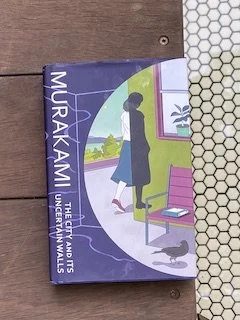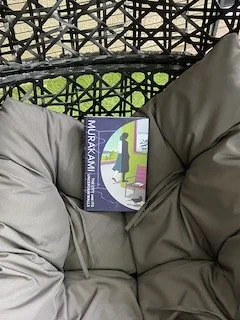The City and its Uncertain Walls by Haruki Murakami
Haruki Murakami’s long-awaited 2024 novel, The City and Its Uncertain Walls, is a quiet, melancholic return to themes that have defined his most haunting work — memory, loneliness, and the blurred line between inner and outer worlds. Based on a short story he abandoned in the 1980s, this novel is both a reimagining and a reckoning.
But is The City and Its Uncertain Walls worth reading? In this ‘as usual spoiler-free review,’ I explore how this slow-burning, introspective book compares to Murakami classics like Norwegian Wood and Kafka on the Shore, and why it might (or might not) earn a place among his top-tier novels. If you’re drawn to literary fiction that blends emotional realism with metaphysical dreamscapes, this one deserves a close — if quiet — read.
Murakami
I may have mentioned in about a half a dozen posts on the blog that I recently visited Japan. One of the items taking up precious space in my luggage was this 450 page hardback of Murakami’s latest release. I had been waiting for the right time to start it, and what could be better than reading Haruki in Japan? Hell, maybe I’d even read it in a Jazz Kissa, gazing out over a drizzly Tokyo afternoon, nursing a Santory as the strains of John Coltrane’s sax drifted across the room. (I did indeed visit a Jazz kissa, and enjoyed it very much. Murakami himself ran a jazz bar called Peter cat. Named after his cat, apparently.)
The reality turned out to be different. I spent so much time enjoying being in Japan that I didn’t have much time for reading. There were a couple of chapters consumed whilst bleary eyed in a departure lounge in Beijing, and I did get a blissful few hours in a fine hotel in Gora, resting on a hammock in between dips in an Onsen. It was probably here that I had that momment that sometimes happen early on in a book where I thought - Oooh, I’m gonna enjoy this one.
I’ve been reading Murakami for many, many years. I’d say I first encountered him back in the nineties - ‘The wind up bird chronicle’ would have been my first introduction to his work. I’ve read most of his books since, and I’d say ‘Kafka on the Shore’ and ‘Norwegian Wood’ are probably obvious highlights. ‘After Dark’ was a recent read and I enjoy being in his worlds.
So Murakami’s take on Japan has certainly been an influence over the years.
Murakami ‘The City and it’s uncertain walls’ beside a heated footbath -Ashiyu - in Gora
Part One
The city of the title doesn’t exist in the reality that we know. It’s walls are obviously symbolic of inner and outer worlds - psychological and existential. There are strange shaggy creatures, gatekeepers and jobs that involve dream reading - it’s an odd place, colourless and muted, and the people live repetitive lives.
The central library is an important building, a sort of archive of lost souls, and the boy is here because he’s in love with the local librarian. He longs to connect with her, and they share a solitude together, but there remains a tension between them.
There’s a certain type of woman in Murakami novels that fits this type - enigmatic and self contained. And their relationship also has that unfulfilled longing, this sense of a emotional gap between them that lies at the heart of the novel. Can two people really connect in a meaningful way, or are we stuck with concepts about one another that we will ultimately never be fulfilled by?
I get that the city is allegorical, and not a fully realised place. It took me a wee while to get through this section, but I do tend to read Murakami in a leisurely way. I did find something haunting about this grey, shadowless place but I didn’t really have any emotional resonance with the narrator. There’s a mundanity, a dull dream of a feel to this city and I get why Murakami was going for that. But I was glad to get out of this place and onto the next section.
Part Two
This is more like it. Cats! Cafe’s! Humans interacting with each other! I sort of joke, but I was happy to leave the monochrome city for this section, largely set in a small rural town. The teenage boy we met earlier is now a middle age man, and has carved out a life for himself as a librarian.
We are still in Murakami world, thankfully, so the previous head librarian is a strange, fleeting figure, whilst there’s a silent boy who visits everyday and has taken an interest in the narrator. All is not what it seems.
I liked the pace to this, and felt more of an emotional connection to the narrator. He is also undergoing a process of processing grief and longing, and his loneliness was something I could relate to. There’s more movement here, he’s interacting with people and even the strange events make a bit more sense.
By far my favourite section.
A hammock in a hotel in Japan I wish I was still lying in reading Murikami’s ‘The City and it’s uncertain walls’
Part Three
Hmmm. It’s overly simple to say part three is a blend of the previous two sections, but that’s what it is. That surreal grey world meeting the emotional resonance of part two. Those barriers between two worlds have really collapsed now, and a sort of reckoning and integration takes place. Honestly, your ‘enjoyment’ of this section will probably depend on how much you ‘get’ Murakami.
I was OK with it, and a lot of the themes explored previously, such as ageing, loss and memory, come together in Murakami’s meditative, unique style. There aren’t any easy answers and you will take from the book what you will. I found a certain tender, haunting quality to the ending.
Summary
It took me a while to get into ‘The City and it’s uncertain walls’ but by books end, especially after part two, I was much more involved. It’s a story about grief and emotional distance, about loss and memory, and maybe more emotionally resonant than some of his other books.
At times it felt like it occupied that space where you have a memory of a person or a past event, but when you examine it there’s a looseness to it. Were they like that? Did it really happen in that way? Memory is unreliable, but we use it to shape the narrative of our pasts. Taking the blocks out of the wall can bring the whole thing down, and it becomes porous. I think if that was the ground the now older Murakami was trying to occupy, he certainly succeeded.
More mature and reflective, perhaps, though I do get how the pacing of part one won’t be for everyone. For me, it’s maybe a bit short of top tier Murakami, but the themes will be familiar to regular readers. I suppose one of the reasons I’ve always loved his books is that many of them are a meditation on loneliness.
You can probably tell from this book blog that I’m perfectly ok with slow burn philosophical books and there’s something haunting, still and poignant about this book that I really enjoyed.
Vintage Publishing
Publish Date 19 November 2024
449 Pages Hardback
I no longer include Amazon links in my reviews. Please support your local library and bookshops. Libby is also great.
If you do wish to purchase online, feel free to support independent bookshops and contribute to the hosting of this website by purchasing via Bookshop.org




